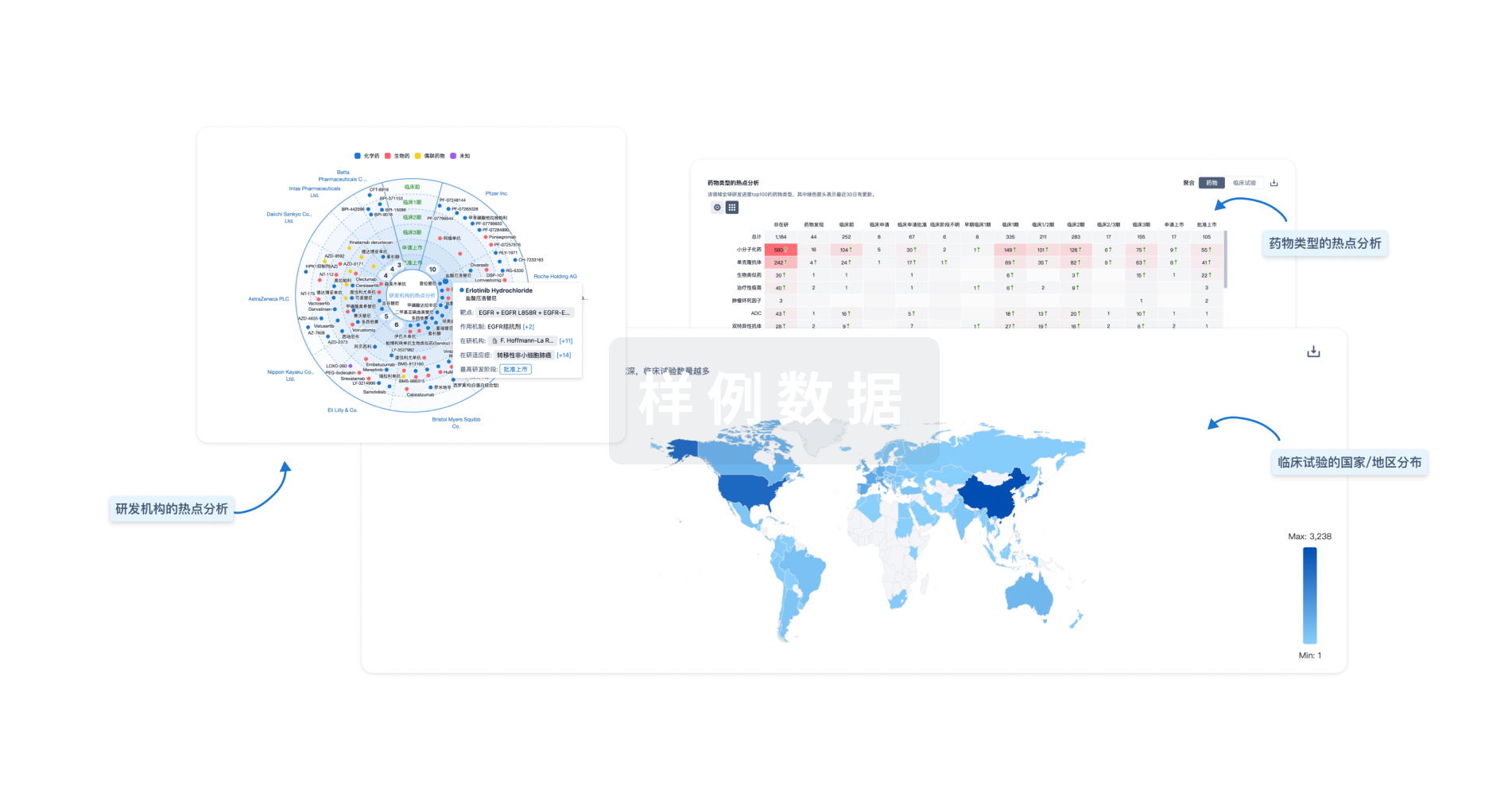预约演示
更新于:2025-05-07
Enthesitis
附着点炎
更新于:2025-05-07
基本信息
别名 Enthesitis、Enthesitis (disorder)、Inflammation of sharpey fibers + [4] |
简介 Inflammation at the site of insertion of ligaments, tendons, and other fibrous structures into bone. |
关联
2
项与 附着点炎 相关的药物靶点 |
作用机制 IL-17A抑制剂 |
最高研发阶段批准上市 |
首次获批国家/地区 日本 |
首次获批日期2014-12-26 |
靶点 |
作用机制 TNF-α抑制剂 |
最高研发阶段批准上市 |
首次获批国家/地区 美国 |
首次获批日期2009-04-24 |
18
项与 附着点炎 相关的临床试验NCT06144567
Ultrasound-based Response of Enthesitis to Upadacitinib in Psoriatic Arthritis
Primary objective To evaluate the peripheral enthesitis response to upadacitinib treatment by BMUS and DMUS, in PsA patients at week 24.
Secondary objective:
To evaluate the peripheral enthesitis response to upadacitinib treatment by BMUS and DMUS, in PsA patients at week 12.
To evaluate the clinical response of enthesitis to upadacitinib by LEI, at week 12 and week 24.
To evaluate the clinical response of disease activity by DAPSA, at week 12 and week 24.
Study Design: single-arm, observational longitudinal, prospective study
Population: The study population will consist of adult patients (aged ≥ 18 years old and ≤ 65 years old) with PsA according to CASPAR classification criteria, who have been prescribed upadacitinib over the course of routine practice, in accordance with the applicable approved label and local regulatory and reimbursement policies ("In patients with psoriatic arthritis, upadacitinib would be a therapeutic alternative after failure, inadequate response or intolerance to csDMARDs and anti-TNF") and have at least one ultrasound-determined peripheral enthesitis.
Secondary objective:
To evaluate the peripheral enthesitis response to upadacitinib treatment by BMUS and DMUS, in PsA patients at week 12.
To evaluate the clinical response of enthesitis to upadacitinib by LEI, at week 12 and week 24.
To evaluate the clinical response of disease activity by DAPSA, at week 12 and week 24.
Study Design: single-arm, observational longitudinal, prospective study
Population: The study population will consist of adult patients (aged ≥ 18 years old and ≤ 65 years old) with PsA according to CASPAR classification criteria, who have been prescribed upadacitinib over the course of routine practice, in accordance with the applicable approved label and local regulatory and reimbursement policies ("In patients with psoriatic arthritis, upadacitinib would be a therapeutic alternative after failure, inadequate response or intolerance to csDMARDs and anti-TNF") and have at least one ultrasound-determined peripheral enthesitis.
开始日期2023-12-01 |
NCT06686082
Effectiveness of Biologics on Synovitis and Enthesitis Using Musculoskeletal Ultrasound Assessment in Subclinical Psoriatic Arthritis: a 12-week Observational Real-world Study
Psoriatic arthritis (PsA) is one of the most common comorbidities in patients with psoriasis (PsO). Current research suggests that the progression from PsO to PsA can be divided into five stages of the disease: PsO, preclinical PsA, subclinical PsA, prodromal PsA, and clinical PsA. Subclinical PsA refers to psoriasis participants who do not exhibit any clinical symptoms of arthritis but show evidence of synovio-enthesitis on ultrasound (US). However, there is currently no definitive biomarker that can accurately predict the progression from PsO to PsA. Synovitis and enthesitis are considered important features of PsA. Musculoskeletal ultrasound, using B-mode ultrasound and power Doppler (PD), can visualize synovitis and enthesitis, allowing for the early detection of subclinical PsA, as confirmed by multiple studies. Biologics are currently widely used in the treatment of PsA, with current treatment interventions primarily focusing on patients already diagnosed with PsA. In this study, we conducted a rigorous screening process to identify potential subclinical PsA patients among those with moderate to severe psoriasis. We treated these subclinical PsA patients with biologics and used musculoskeletal ultrasound as a method of efficacy assessment to observe the improvement of synovitis and enthesitis in subclinical PsA patients after 12 weeks of treatment.
开始日期2023-11-01 |
申办/合作机构 |
DRKS00025563
The DIagnostic VAlue of Musculoskeletal UltraSound (MSUS) in the detection of Early signs ofpsoriatic arthritis - An open label, proof-of-concept study using Apremilast in a cohort of very earlypsoriatic arthritis in patients with ultrasound-enthesitis and arthralgia (The DIVAMUSE-study) - DIVAMUSE
开始日期2022-05-01 |
100 项与 附着点炎 相关的临床结果
登录后查看更多信息
100 项与 附着点炎 相关的转化医学
登录后查看更多信息
0 项与 附着点炎 相关的专利(医药)
登录后查看更多信息
2,174
项与 附着点炎 相关的文献(医药)2025-12-01·Current Rheumatology Reports
A Review on Imaging in Axial Spondyloarthritis: SPARTAN 2024 Annual Meeting Proceedings
Review
作者: Bittar, Mohamad ; Maksymowych, Walter P
2025-07-01·Cellular Signalling
Mechanical stretch promotes the neutrophil recruitment potential of fibroblasts through the Piezo/NFAT1/LIF axis
Article
作者: Zhang, Weihao ; Lin, Jiajie ; Wu, Yanfeng ; Shen, Guozhen ; Yu, Wenhui ; Li, Jinteng ; Li, Zhikun ; Xiao, Zipeng ; Su, Zepeng ; Xie, Zhongyu ; Zeng, Yipeng ; Zhou, Yi ; Wang, Peng ; Shen, Huiyong
2025-04-01·Seminars in Arthritis and Rheumatism
Disease characteristics, co-morbidities and treatment response in a contemporary axial spondyloarthritis cohort: Analysis of 717 patients from the Greek AxSpA registry
Article
作者: Tektonidou, Maria G ; Fragoulis, George E ; Kaltsonoudis, Evripidis ; Koutsianas, Christos ; Kougkas, Nikolaos ; Skepastianos, Vasileios ; Zoupidou, Konstantina ; Karamanakos, Anastasios ; Mole, Evangelia ; Fytanidis, Nikolaos ; Karokis, Dimitrios ; Patrikos, Dimos ; Pappa, Maria ; Daoussis, Dimitrios ; Grika, Eleftheria P ; Voulgari, Paraskevi V ; Kalavri, Eleni ; Koletsos, Nikolaos ; Gazi, Sousana ; Katsimpri, Pelagia ; Sampatakaki, Eleni ; Papagoras, Charalampos ; Dimitroulas, Theodoros ; Krikelis, Michael ; Vassilopoulos, Dimitrios ; Konsta, Maria ; Kataxaki, Evangelia ; Sfikakis, Petros P ; Bournazos, Ilias ; Klavdianou, Kalliopi ; Iliopoulos, Georgios ; Iliopoulos, Alexios ; Sfontouris, Charalampos ; Katsifis, Gkikas ; Mavrea, Evgenia ; Kottas, Konstantinos
70
项与 附着点炎 相关的新闻(医药)2025-05-03
·恒瑞医药
—————————每年5月的第一个星期六是世界强直性脊柱炎国际联盟(ASIF)倡议设立的世界强直性脊柱炎日,旨在普及强直性脊柱炎的基本知识、提高大众和患者认知,降低疾病给患者身心带来的危害。强直性脊柱炎(Ankylosing Spondylitis,AS)是一种慢性炎症性疾病,主要破坏脊柱、骶髂关节,还可累及外周关节、关节外器官。目前我国AS患者有近400万(患病率0.3%左右)[1]。AS起病隐袭,其特征性标志和早期表现之一为骶髂关节炎,附着点炎为本病的特征性病理改变,患者常出现腰背部或骶髂部疼痛和/或晨僵,多数病情会由腰椎向胸、颈椎发展,严重影响患者生活质量,降低生存率[1]。AS作为一种慢性疾病,其治疗目标是缓解症状和体征、恢复功能、防止关节损伤、提高患者生活质量、防止脊柱疾病的并发症。AS的治疗包括非药物治疗、药物治疗和外科治疗。早期以药物治疗为主,晚期脊柱或髋、膝等大关节发生强直或严重畸形时以外科手术治疗为主。非甾体抗炎药(Non-steroidal anti-inflammatory drugs,NSAIDs)是治疗AS的一线药物,对NSAIDs治疗后病情仍活动或者不耐受的AS患者,推荐使用生物制剂类药物[2]。虽然目前AS无法根治,但通过科学治疗和康复锻炼,大多数患者可以维持正常的生活和工作能力,其关键在于早发现、早治疗,配合科学的康复管理,定期复查和调整治疗方案控制病情进展。多年来,恒瑞医药始终关注强直性脊柱炎等免疫系统疾病领域临床需求,致力于通过创新研发为患者带来更多治疗选择。其中,中国首个自主研发的JAK1抑制剂用于对一种或多种TNF抑制剂疗效不佳或不耐受的活动性强直性脊柱炎成人患者适应症已获批上市,研究表明[3],其在临床试验中表现出了良好的有效性和安全性,标志着中国自主研发JAK1抑制剂在口服制剂技术水平上取得了新的飞跃,为AS治疗提供新的"中国方案"。公司自主研发的重组抗IL-17A人源化单克隆抗体用于常规治疗疗效欠佳的活动性强直性脊柱炎成人患者适应症也已获批上市,研究结果显示[4]:与安慰剂相比,IL-17A单克隆抗体对活动性强直性脊柱炎具有统计学显著性和临床意义的改善,为AS成人患者带来新的治疗选择和希望。此外,JAK1抑制剂还开展了用于活动性放射学阴性中轴型脊柱关节炎的临床研究,目前已推进至Ⅲ期。未来,恒瑞医药将继续坚持“以患者为中心”的理念,持续关注强直性脊柱炎治疗现状,致力于相关药物的研究和应用,以期为患者带来更多治疗选择,为守护患者健康贡献恒瑞力量。参考文献:1.黄烽,朱剑,王玉华,等. 强直性脊柱炎诊疗规范[J]. 中华内科杂志,2022,61(8):893-900.2.Ramiro S, Nikiphorou E, Sepriano A, et al. ASAS-EULAR recommendations for the management of axial spondyloarthritis: 2022 update. Ann Rheum Dis. 2023;82(1):19-34.3.2024 EULAR poster: https://doi-org.libproxy1.nus.edu.sg/10.1136/annrheumdis-2024-eular.1981.4.POS0803:VUNAKIZUMAB IN ACTIVE ANKYLOSING SPONDYLITIS: A RANDOMIZED, DOUBLE-BLIND, ADAPTIVE, SEAMLESS, PHASE 2/3 STUDY.DOI: 10.1136/annrheumdis-2024-eular.868排版:程梦真责编:王玲往期精选| 研发创新 |恒瑞创新药、中国首个自主研发JAK1抑制剂硫酸艾玛昔替尼片获批上市全球首个超长效PCSK9单抗!恒瑞降脂创新药瑞卡西单抗获批上市| 国际化 |恒瑞医药与默沙东就Lp(a)抑制剂HRS-5346签订独家许可协议| 重磅奖项 |喜报!恒瑞医药荣获2023年度国家科技进步奖恒瑞医药连续六年入选全球制药企业50强榜单!| 社会公益 |“健康中国行·重走长征路”项目启动仪式圆满举行!恒瑞提供公益支持,助力健康中国恒瑞医药集团向中国扶贫基金会捐赠3000万设立“健康帮扶基金”
临床3期临床结果放射疗法
2025-04-14
近日,恒瑞医药子公司、BioBAY园内企业盛迪亚收到国家药品监督管理局核准签发夫那奇珠单抗(安达静®)的《药品注册证书》,批准增加适应症:本品适用于常规治疗疗效欠佳的活动性强直性脊柱炎(AS)成人患者。此次获批新适应症标志着中国自主研发重组抗IL-17A人源化单克隆抗体在AS治疗领域取得了重要突破,将为AS成人患者带来新的治疗选择和希望。AS是一种慢性炎症性疾病。目前我国AS患者有近400万(患病率0.3%左右)。AS起病隐袭,其特征性标志和早期表现之一为骶髂关节炎,附着点炎为本病的特征性病理改变,患者常出现腰背部或骶髂部疼痛和/或晨僵,多数病情会由腰椎向胸、颈椎发展,严重影响患者生活质量,降低生存率。传统药物可改善炎症临床症状,但对附着点炎和结构进展疗效欠佳;而生物制剂直接作用于AS炎症级联核心(涉及IL-17A、TNF-α等炎性细胞因子),TNF抑制剂可改善患者症状和附着点炎,对Th17细胞介导的IL-17A等通路调控有限,广泛抑制还可能导致安全性风险增加。因此,临床亟需强效且安全的治疗新手段。近年来,随着对AS发病机制的研究不断深入,发现IL-17A是驱动AS慢性炎症主要效应因子,能作用于多种类型的下游细胞,进而促使细胞因子和趋化因子的释放,引发炎症等一系列病理反应。此外,IL-17A也是调控AS附着点炎病理进程的关键细胞因子,并参与了AS骨代谢的调控,在骨侵蚀和新骨形成中均发挥重要作用。最后,IL-17A还介导了AS的炎症性和神经病理性疼痛,造成患者的疼痛反应。因此,IL-17A抑制剂等创新药物已逐渐成为AS的重要治疗手段之一。夫那奇珠单抗是人源化的IgG1抗IL-17A单克隆抗体,保持与IL-17A的高亲和力,可选择性地与IL-17A结合,阻断其与受体的作用,从而抑制下游信号通路,为AS的精准靶向治疗提供了新的思路。此次新适应症获批是基于一项在全国开展的随机、双盲、多中心、安慰剂对照的适应性无缝II/III期临床研究。研究结果显示:与安慰剂相比,夫那奇珠单抗对活动性强直性脊柱炎具有统计学显著性和临床意义的改善——第16周,夫那奇珠单抗组较安慰剂显著提升ASAS 20、ASAS 40应答率分别至65.6%与46.3%,ASAS 5/6应答率提升至55.4%。安全性方面,夫那奇珠单抗组核心期不良事件发生率与安慰剂组相似,无受试者因为不良反应而停止治疗或终止研究。此外,夫那奇珠单抗密集期仅需注射3次,全年注射14次,注射便捷性大大提高。▌文章来源:盛迪亚责编:赵家帅审核:任旭推荐阅读全球首个!盛迪亚抗PD-L1/TGF-βRII双功能融合蛋白申报上市研发动态丨中国首款saRNA药物获批临床!中美瑞康RAG-1C开启PVR治疗新篇章研发动态丨丹诺医药启动TNP-2092关节腔注射给药治疗人工关节感染2期临床试验
临床结果申请上市临床研究
2025-04-10
·健识局
近日,恒瑞医药子公司苏州盛迪亚生物医药有限公司宣布,其自主研发的1类创新药——夫那奇珠单抗(安达静)已正式获得国家药品监督管理局(NMPA)的批准,适用于常规治疗疗效欠佳的活动性强直性脊柱炎(AS)成人患者。此次获批标志着继银屑病(PsO)适应症之后,中国自主研发的人源化抗IL-17A单克隆抗体在AS治疗领域取得了重大突破,为AS患者带来了新的治疗选择和希望。AS是一种慢性炎症性疾病,目前我国AS患者有近400万。AS起病隐袭,其特征性标志和早期表现之一为骶髂关节炎,附着点炎为本病的特征性病理改变,患者常出现腰背部或骶髂部疼痛和/或晨僵,多数病情会由腰椎向胸、颈椎发展,严重影响患者生活质量,降低生存率。此次新适应症获批是基于一项在全国开展的随机、双盲、多中心、安慰剂对照的适应性无缝II/III期临床研究。研究结果显示:与安慰剂相比,夫那奇珠单抗对活动性强直性脊柱炎具有统计学显著性和临床意义的改善——第16周,夫那奇珠单抗组较安慰剂显著提升ASAS 20、ASAS 40应答率分别至65.6%与46.3%,ASAS 5/6应答率提升至55.4% 。在安全性方面,夫那奇珠单抗组核心期不良事件发生率与安慰剂组相似,无受试者因为不良反应而停止治疗或终止研究。此外,夫那奇珠单抗密集期仅需注射3次,全年注射14次,注射便捷性高。运营|李木子声明:健识局原创内容,未经许可请勿转载“最大”连锁药店,去年关店1270家三次IPO失败,曾被举报财务造假,中药饮片巨头转战港交所新事 | 艾迪药业:新冠特效药,停止开发!
IPO临床2期
分析
对领域进行一次全面的分析。
登录
或

生物医药百科问答
全新生物医药AI Agent 覆盖科研全链路,让突破性发现快人一步
立即开始免费试用!
智慧芽新药情报库是智慧芽专为生命科学人士构建的基于AI的创新药情报平台,助您全方位提升您的研发与决策效率。
立即开始数据试用!
智慧芽新药库数据也通过智慧芽数据服务平台,以API或者数据包形式对外开放,助您更加充分利用智慧芽新药情报信息。
生物序列数据库
生物药研发创新
免费使用
化学结构数据库
小分子化药研发创新
免费使用



